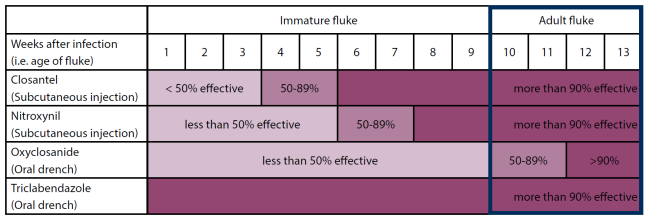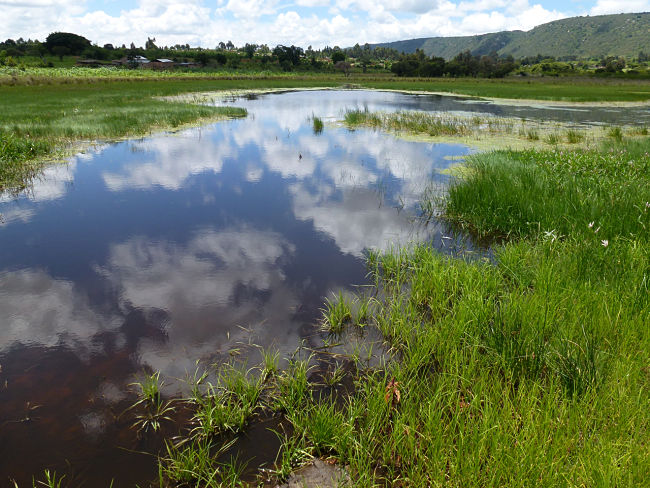Rates of giant liver fluke and rumen fluke in cattle: implications for effective control in Tanzania

Parasite infections in cattle have a major impact, including on human health. This research into infection rates and effective treatment options has led to evidence-based guidelines for effective and sustainable control of giant liver fluke and rumen fluke in cattle in Tanzania.
About the research
Parasites affect the health and productivity of cattle by reducing milk production, growth rate and fertility, and increasing mortality and susceptibility to other diseases.
In turn this affects crop production, as working animals are less effective, and has social implications in regions where cattle are indicators of wealth and social status.
Where water sources are shared, liver fluke can also infect people; leading to liver rot (fascioliasis) or in rare cases incurable bile duct cancer.
The World Health Organisation class both liver and rumen fluke infection as neglected tropical diseases; insufficient research and funding means that farmers, vets and health professionals lack the resources to tackle endemic infection.
Understanding the regional prevalence of infection in cattle and the control options available is therefore important to maintain cattle productivity and protect public health.
This collaborative research between Tanzanian and UK universities has provided up to date estimates for liver and rumen fluke prevalence in cattle in Tanzania, and evaluated the efficacy of the available treatments.
The results have informed new evidenced-based guidelines for liver and rumen fluke control in cattle where giant liver fluke (Fasciola gigantica) is the predominant species.
Unless indicated otherwise, all mentions of liver fluke in this article refer to giant liver fluke.
Image by Hannah Rose Vineer
Policy recommendations
Avoid infection
• Cattle should be grazed on drier land away from high risk areas (irrigated areas, seasonally wet land, near permanent water sources)
• Housed cattle should be fed forage from low risk areas (without irrigation or water sources potentially contaminated by aquatic snails)
• If cattle are grazed in high risk areas or fed forage from high risk areas they should be treated at least once a year with an appropriate flukicide to maintain good health and productivity
Use the right flukicide to treat infection
• Ensure the product used is effective against the target fluke species (see Table 1)
• Use the product most appropriate to the age of fluke requiring treatment ( see Table 2)
• Products containing tricabendazole should be used only when appropriate as overuse may lead to resistance (see Treatment and Timing)
Treat at the right time
• Treatment should aim to reduce the burden of infection in cattle and to reduce contamination of snail habitat with fluke eggs.
• Optimal timing depends on local conditions and management practices, e.g. treat prior to housing periods or towards the end of the dry season.
Prevalence surveys: how common is fluke infection?
Cattle in 15 study villages in the Arumeru District and 15 study villages in the Iringa District of Tanzania were tested for liver and rumen fluke in faeces. This updated existing fluke infestation data for Iringa and provided information for Arumeru for the first time.
The villages in Iringa were either highland (more than 1500 metres above sea level) or lowland to compare infection rates and association with altitude.
The villages in Arumeru comprised three management types to compare prevalence between management systems.


Key findings
• The percentage of cattle affected by liver and rumen fluke (prevalence) was high overall, ranging from 15-85 per cent
• Fluke was more common in villages with irrigation
• Fluke was more common in highland than lowland villages
• More fluke was found in cattle in Iringa than in Arumeru
• Cattle housed fulltime had high rates of liver and rumen fluke prevalence. This was attributed to fluke infestation at the sites where grass for feed was cut.
Sustainable treatment relies on using an effective product at the right time
What works: efficacy of flukicides against liver and rumen fluke
The efficacy of a range of flukicides were tested using a Faecal Egg Count Reduction Test (table 1).
This test involved counting fluke eggs in faecal samples from 120 individual animals on the day of treatment and at intervals following treatment.
Effective flukicides | ||
|---|---|---|
| Active ingredient | Giant liver fluke | Rumen fluke |
| Albendazole | x | x |
| Closantel | √ | x |
| Nitroxynil | √ | x |
| Oxyclosanide | √ | √ |
| Triclabendazole | √ | x |
Treatment and timing
In the absence of timing data for giant liver fluke, data on effective treatments for common liver fluke (table 2) can be used as a guide. Albendazole is not shown as our study shows it may be ineffective in these regions.
Triclabendazole is effective at all stages, but resistance is emerging worldwide and therefore should only be used when necessary. Since fasciolosis in cattle is usually chronic and caused by adult fluke, other treatments are effective.

Table 2: The efficacy of flukicides against common liver fluke, Fasciola hepatica (Source: Fairweather and Boray (1999), Moredun (2005), NOAH (2015))
Further information
Nzalawahe, J., Kassuku, A. A., Stothard, J. R., Coles, G. C., & Eisler, M. C. (2014). Trematode infections in cattle in Arumeru District, Tanzania are associated with irrigation. Parasites & Vectors, 7(107). doi.org/10.1186/1756-3305-7-107
Nzalawahe, J., Kassuku, A. A., Stothard, J. R., Coles, G. C., & Eisler, M. C. (2015). Associations between trematode infections in cattle and freshwater snails in highland and lowland areas of Iringa Rural District, Tanzania. Parasitology(142), 1430-1439. doi.org/10.1017/S0031182015000827
Nzalawahe, J., Hannah, R., Kassuku, A.A. et al. (2018). Evaluating the effectiveness of trematocides against Fasciola gigantica and amphistomes infections in cattle, using faecal egg count reduction tests in Iringa Rural and Arumeru Districts, Tanzania. Parasites & Vectors 11, 384. doi.org/10.1186/s13071-018-2965-7
Acknowledgements
Dedication
We dedicate this work to the late Professor Ayub Ahmad Kassuku who devoted his career to the investigation and control of helminth parasites of livestock in Tanzania and inspired his students and fellow researchers with his great experience and knowledge.
Policy Report 21: Jan 2018
Rates of giant liver fluke and rumen fluke in cattle: implications for effective (PDF, 296kB)
Contact the researchers
Professor Mark Eisler
University of Bristol
Dr Jahashi Nzalawahe
Sokoine University of Agriculture
Authors
Professor Mark Eisler, Dr Hannah Rose Vineer, Dr Gerald Coles, (University of Bristol, United Kingdom)
Professor Ayub Kassuku, Dr Jahashi Nzalawahe (Sokoine University of Agriculture, Tanzania)
Professor Russell Stothard (Liverpool School of Tropical Medicine, United Kingdom)



Fluke factsheet
Distribution
Fluke infections are most prevalent in areas with high humidity and high annual rainfall because the life cycle depends on the presence of aquatic/semi-aquatic snails.
Permanent water bodies may be suitable habitat for the water snails which carry liver and rumen fluke.
These snails can survive in seasonally wet areas, such as floodplains and the banks surrounding water bodies and rivers. These areas, if grazed, should also be considered a risk.

Image: Mark Eisler
Species
Liver fluke: The giant liver fluke (Fasciola gigantica) is the most widespread liver fluke species affecting cattle in Africa. In other regions common liver fluke (Fasciola hepatica) is more widespread. Liver fluke infections can occur in humans.
Rumen fluke (Paramphistomes): Many species of rumen fluke infect cattle. The life cycle is similar to liver fluke except the adults live in the rumen. Rumen fluke infection does not occur in humans.
Unless indicated otherwise, all mentions of liver fluke in this document refer to giant liver fluke.

Further information
Jorgen Hansen and Brian Perry https://cgspace.cgiar.org/handle/10568/49809
Lughano Kusiluka and Dominic Kambarage http://bit.ly/2u0qIkW
